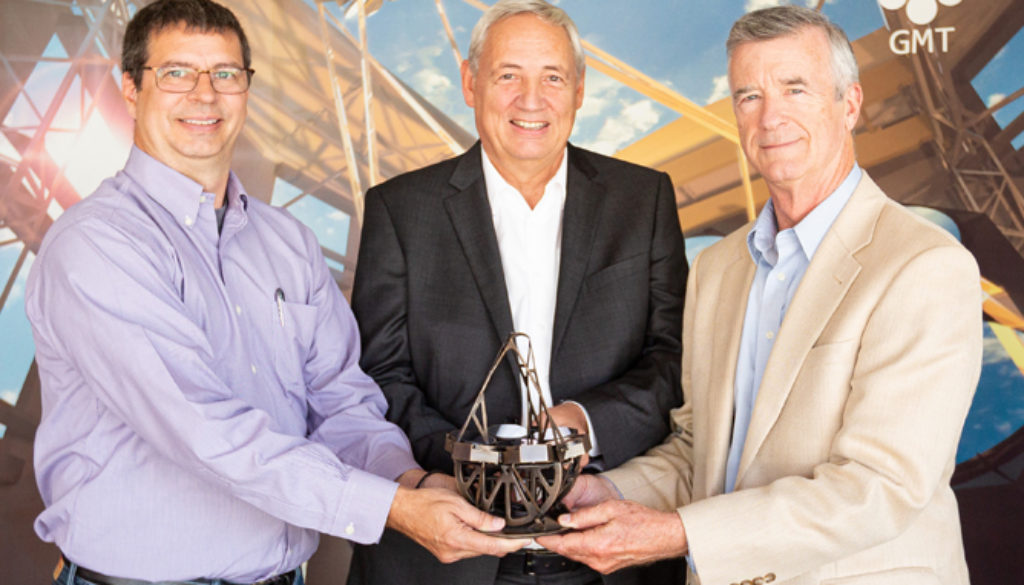Giant Magellan Telescope Signs Contract for Telescope Structure
GMTO Corporation, the organization managing the development of the Giant Magellan Telescope (GMT) on behalf of its U.S. and international founders including Texas A&M University, has signed a contract with MT Mechatronics and Ingersoll Machine Tools to design, build and install the telescope’s precision steel structure.

Latest design of the Giant Magellan Telescope enclosure, telescope and site at Las Campanas Observatory in Chile. (Credit: GMTO Corporation.) 
The GMT telescope structure showing the six 8.4-meter off-axis segments arrayed around a central on-axis 8.4-meter segment that comprises GMT’s unique primary mirror configuration. The grey cylinder at the bottom is the telescope pier – the concrete foundations. The widest orange ring designates the observing floor of the enclosure. The grey semi-circular structure above this is known as the C-Ring. The C-Ring structure is supported by 16 radial hydrostatic bearings that counteract the force of gravity and allow the telescope to move smoothly. The light blue hexagonal structures are the mirror cells that hold the primary mirrors and their support mechanisms. Finally, at the top of the main truss, the Top End supports the secondary mirror assembly. (Credit: GMTO Corporation.) 



Latest design of the Giant Magellan Telescope enclosure, telescope and site at Las Campanas Observatory in Chile, with a night sky background. (Credit: M3 Engineering and GMTO Corporation.)
Since its inception in 1891, Ingersoll Machine Tools Inc. has been an iconic name in the milling machines sector, successfully serving the defense sector and then the newborn aeronautics and aerospace industry. Ingersoll has many decades of experience with manufacturing precision steel structures, including recently partnering with MT Mechatronics on the construction of the DKIST telescope mount.
The contract between GMTO, MT Mechatronics and Ingersoll Machine Tools will involve nine years of work and 1,300 tons of structural steel. The structure is expected to be delivered to Chile at the end of 2025 and be ready to accept mirrors in 2028.
The mount contract completes another significant milestone for GMTO in 2019. In March, the excavations for the foundations of the telescope’s pier and enclosure were finished, and in July the second of GMT’s seven primary mirror segments was completed and shipped to temporary storage. Casting of the sixth primary mirror segment at the University of Arizona is expected to begin in mid-2020.
# # # # # # # # # #
About the Giant Magellan Telescope: The Giant Magellan Telescope is a next-generation ground-based telescope that promises to revolutionize our understanding and view of the universe. The GMT is poised to enable breakthrough discoveries in cosmology, the study of black holes, dark matter, dark energy, and the search for life beyond our solar system. The telescope’s primary mirror combines seven 8.4-meter (27 feet) diameter circular segments to form an effective aperture 24.5 meters in diameter. The GMT will be located at Las Campanas Observatory in Chile’s Atacama Desert and the project is the work of a distinguished international consortium of leading universities and science institutions. Funding for the project comes from the partner institutions, governments and private donors.
About the Giant Magellan Telescope Organization: The Giant Magellan Telescope Organization (GMTO) manages the GMT project on behalf of its international partners: Arizona State University, Astronomy Australia Ltd., The Australian National University, Carnegie Institution for Science, Fundação de Amparo à Pesquisa do Estado de São Paulo, Harvard University, Korea Astronomy and Space Science Institute, Smithsonian Institution, Texas A&M University, The University of Arizona, The University of Chicago, and The University of Texas at Austin. For more information, visit www.gmto.org.
About Research at Texas A&M University: As one of the world’s leading research institutions, Texas A&M is at the forefront in making significant contributions to scholarship and discovery, including in science and technology. Research conducted at Texas A&M generated annual expenditures of more than $922 million in fiscal year 2018. Texas A&M ranked in the top 20 of the National Science Foundation’s Higher Education Research and Development survey (2017), based on expenditures of more than $905.4 million in fiscal year 2017. Texas A&M’s research creates new knowledge that provides basic, fundamental and applied contributions resulting, in many cases, in economic benefits to the state, nation and world. To learn more, visit http://research.tamu.edu.
-aTm-
Contact: Amanda Kocz, akocz@gmto.org; Dr. Robert N. Shelton, rshelton@gmto.org; or Dr. James Fanson, jfanson@gmto.org
The post Giant Magellan Telescope Signs Contract for Telescope Structure appeared first on College of Science.
